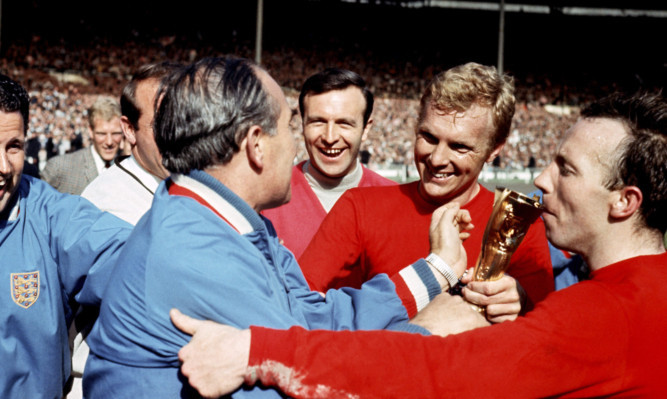
If the 1950s were to establish football as the working man’s game, the following decade elevated the sport to the cultural phenomenon it is today.
The 60s opened with the event that was to change the way the game worked for ever.
With crowds booming, players began to realise that club owners were pocketing ever-increasing profits while the men who generated the interest and excitement were making no more money than a miner or an office clerk. During 1960, the PFA, led by Jimmy Hill, organised a campaign seeking the abolition of the maximum wage, which then stood at £20 per week, and of the system that enabled clubs to retain a player’s registration. The authorities offered the players a gradual increase to £30 a week over the next five years but the PFA voted unanimously for strike action.
The strike was called for January 21, 1961, but three days before it was due to start, the people who ran the game caved in and it was agreed to abolish the maximum wage. The strike was called off. This breakthrough saw Fulham and England captain Johnny Haynes become the country’s first £100-per-week player.
With the 60s beginning to swing, it was the dawning of the age of the footballing celebrity. And, of course, the game’s equivalent of the pop star culture was spearheaded by a Belfast boy with a Beatles haircut. George Best combined sublime skill with poster boy glamour. He ran rings round defenders, scored exciting goals, opened boutiques, drove flash cars and always got the girl. Football was suddenly trendy. It started attracting a younger audience with a higher percentage of female followers.
https://youtube.com/watch?v=c7l_DKlekwA
Television began to play a part in marketing the game when the first edition of Match of the Day was screened in August, 1964.
At club level, the decade was dominated by five emerging new powers. Best’s Manchester United did battle with Don Revie’s machine-like Leeds, a Bill Shankly-inspired Liverpool, Chelsea’s King’s Road crew led by Peter Osgood and the Manchester City team that included Bell, Lee and Summerbee. There was also an increasing awareness that British football no longer existed in isolation.
The drubbings England took back in the 50s from Hungary, plus the all-conquering exploits of Real Madrid, made us aware of the importance of competing internationally at both club and country levels. At the start of the new decade, Madrid beat Eintracht Frankfurt in the European Cup Final in a game that showed them at the very peak of their abilities. With Alfredo di Stefano and the “Galloping Major” Ferenc Puskas in their ranks, Madrid won 7-3 in front of 137,000 at Hampden Park, the largest crowd ever to attend a European Cup game. Puskas scored four and di Stefano scored a hat-trick. But both were reaching the end of their careers and for Real, it was the conclusion of their run of five consecutive European Cup wins. But the next European superstar was already waiting in the wings, and Eusebio inspired Benfica to the trophy for the following two years.
By the mid-60s, though, the flair of Iberia had been replaced by the functionality of Italian football. The Milan clubs began to gain a strong grip on European club football with their “catenaccio” style of defence which involved a sweeper. Manchester United, with Best, Law and Charlton in their team, tried and failed to break the dominance and lift the trophy that had been pursued by Matt Busby since the Munich Air Crash. In the end, it was Glasgow Celtic, a team of local-born Scots managed by Jock Stein, who become the first British club to lift the trophy by beating Inter Milan in the 1967 final in Lisbon.
The following season, Busby finally got his hands on the European Cup. The genius of Best propelled United to Wembley, where they defeated Eusebio’s Benfica 4-1 after extra-time.
Having won the 1958 World Cup in Sweden, Brazil began the decade as the best team on the planet and they again won the trophy in Chile in 1962. They even managed to do it mostly without the injured Pele, who began and ended the 60s as the best player in the world.
England had their moment, though, and what a moment it was. Sir Alf Ramsey then plain Alf put together a team that relied on work-rate and tactical nous rather than flair. “Alf’s Wingless Wonders”, they were called, after he dispensed with wide players in favour of a packed midfield. Though, in fairness, they did have Bobby Charlton in their ranks and his goals were the key to getting Ramsey’s team into the final against West Germany. After that, industry, dogged determination, home advantage and a little bit of luck combined to enable Bobby Moore to lift the Jules Rimet trophy at Wembley on that July afternoon in 1966.
They always say that if you remember the 60s, you weren’t really there. Well, any football fan who was around at the time will recall exactly where they were when England won the World Cup. England were still World Champions by the time Big Ben’s chimes let in 1970. Like the decade itself, the football had been colourful and entertaining. But an altogether darker era was ahead. And we’ll tell that story next week!

Enjoy the convenience of having The Sunday Post delivered as a digital ePaper straight to your smartphone, tablet or computer.
Subscribe for only £5.49 a month and enjoy all the benefits of the printed paper as a digital replica.
Subscribe